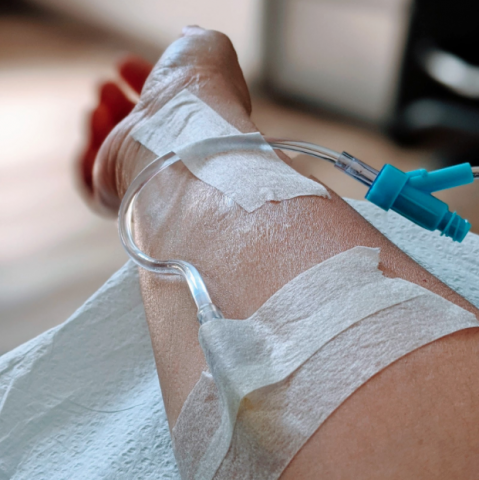
Photo courtesy Gabriela Wijegunawardena
The Journey
Over the past 7 years I've seen: 5 primary care doctors, 2 neurologists, 5 OB-gyn, 1 gastroenterologist, 2 urologists, 1 allergist, 5 dermatologists, 5 ER doctors, 3 functional medicine doctors, 1 ophthalmologist, 1 naturopath, 4 physical therapists, 7 acupuncturists, and 2 craniosacral therapists on a quest to find answers about my health. I'm not a layperson. I wasn't lost in the healthcare system. I know healthcare from the inside out. I have been a nurse for 17 years. I researched every doctor before scheduling an appointment. I prepared a list of questions and concerns for each doctor's visit. Yet the outcome was the same as any other patient's story that results in misdiagnosis and dozens of prescription medications being thrown at symptoms. If I'd been correctly diagnosed from the start, Botox injections to my scalp and occipital nerve blocks to alleviate debilitating migraine pain and occipital neuralgia, an endoscopy, CT scans, MRIs, numerous ultrasounds, and countless lab tests would not have been necessary. Not one doctor was able to determine the cause of my health problems. For starters, most weren't looking for Lyme Disease. Medications served as bandaids, and I was faced with the stark reality that the medical establishment I'd served for so long had failed me.
I hiked regularly in the Bay Area and had a dog when odd symptoms began to appear in 2013. Over the years, I would address one symptom, only to have another emerge months later. Sometimes I'd feel relatively ok for months at a time. My health improved somewhat after being treated for gut dysbiosis, worsening migraines, and interstitial cystitis. However no one could pinpoint the root cause of my growing list of ailments. And I never felt fully well, like my old self.
In 2016, I saw a naturopath who tested me for Lyme Disease as part of my new patient workup, using the standard serological ELISA and Western Blot lab tests. I read my results over and over. Negative. Negative. Negative. At the time, I didn't know these 2 labs are only capable of detecting antibodies to 2 Borrelia bacterium. Lyme Disease had been ruled out. I'd tested negative, had never seen a tick, felt a bite, or had a bull's-eye rash.
A Diagnosis
My health was in a downward spiral by the start of 2020. I still didn't know what was causing my decline, I just knew I needed answers. A friend referred me to Dr. Grieder, an integrative doctor who specializes in treating complex cases. As he looked over my lab results and read my list of chief complaints during our second appointment, he expressed concern Lyme Disease could be at the root of my health problems. I couldn't believe it. Had it been Lyme Disease all along? My body was fighting something, and perceived everything as a threat. Overactive mast cells translated into a myriad of symptoms ranging from histamine intolerance to anxiety and insomnia. He diagnosed me with Mast Cell Activation Syndrome, prescribed medications to stabilize my mast cells, and we agreed to test for Lyme Disease via Igenex. My physical symptoms were beginning to make sense. I finally felt like I was headed in the right direction.
Weeks after my second appointment, I was officially diagnosed with Chronic Lyme Disease (CLD). It is the most common vector-borne disease in the U.S., and is known as the great imitator because it presents like many other diseases, affecting every body system over time as it proliferates and enters the chronic stages. The soft tick that bit me is common in California. It's bite is painless, and it doesn't feed for longer than 30 minutes before falling off.
Health Inequity, Racial Disparities, & Implicit Bias
Once I was officially diagnosed with Lyme Disease, I joined multiple Lyme support groups. I was determined to find answers and connect with others battling the disease. As I explored each group, I noticed the majority of members were white. I yearned to see representation in these groups. Why were so few people of color diagnosed with Lyme Disease?
As I've come to learn, there are many layers to that answer. A textbook bull's-eye rash indicative of Lyme Disease will present differently in Black and Latinx patients with dark skin. If the assessing doctor isn't Lyme-literate, this cardinal sign may be missed. Latinxs are at higher risk for contracting Lyme Disease due to occupational exposure. They comprise 44% of ground maintenance workers and 43% of farmworkers. Because of health inequity, Black and Brown communities have disproportionate access to healthcare. Access to Lyme-literate medical doctors (LLMDs) is problematic, as most are not in-network with health insurance plans, and the cost of treatment falls squarely on the patient's shoulders. Language barriers, fear of deportation, work schedules, and seasonal labor are roadblocks to seeking care early on as well. Lastly, a doctor's bias, implicit or not, will directly impact if and when a diagnosis is made and how a patient's complaints are treated. One study showed that doctors who harbor pro-white implicit biases, were more likely to prescribe pain medications to white patients than to Black patients.
CDC
Another barrier to diagnosis is the Centers for Disease Control and Prevention (CDC) refusal to acknowledge untreated Lyme Disease as a chronic condition. CLD is caused by spirochetes that hide and multiply in deep-seated tissue. It requires long-term intravenous or herbal antibiotic treatment for months, possibly even years to resolve. Once chronic, remission is the best possible outcome.The CDC refers to Lyme Disease symptoms that persist after 4-6 weeks of oral antibiotics as Post-Treatment Lyme Syndrome, and don't recommend further treatment. If you're a fellow Lymie, you know CLD is a very real diagnosis and complex chronic condition.
The steady rise of Lyme Disease over the past 40 years hasn't prompted vector-control by public works as malaria did. No large scale vector-control efforts have been made to address ticks that carry and transmit the disease. Since the CDC doesn't believe CLD is a valid medical diagnosis, insurance companies will continue to deny long-term antibiotic therapy coverage for the treatment of CLD, and hundreds of thousands of people will continue to suffer.
I'm four months into treatment with intravenous and oral antibiotics, and I'm beginning to see more and more glimpses of "the old me." I hope to wrap up treatment sometime this year. I feel fortunate to have found a LLMD that solved my health puzzle, along with caring and skillful nurses that never miss with IV placement. I'm incredibly grateful to have found an acupuncturist who has successfully treated Lyme Disease patients for decades. She has helped my body detoxify and feel calmer, month after month. Everyone deserves to have holistic care, with integrative doctors and acupuncturists working collaboratively with a patient-centered approach. Sadly, this is not the case bein our broken healthcare system.
Tick Bite Prevention Tips
Please be careful out there. Peak tick season is May-July, and some are as small as a poppy seed. According to a CDC study, an estimated 300,000 cases of Lyme Disease are diagnosed each each year. This does not include all tick-borne diseases. There are also many, like myself, who are misdiagnosed and remain untreated. To prevent tick bites, the National Institute for Health recommends:
-
A chemical repellent (DEET, permethrin, or picaridin)
-
Light-colored protective clothing
-
Tucking pant legs into socks on hikes
-
Avoiding tick-infested areas (e.g. old cabins, leaf piles, tall grass, and areas where deer and rodents live)
-
Checking for ticks after hikes or gardening (I also shower, and wash and dry clothes in the dryer on a high setting to kill any ticks that may be present)
Find a LLMD here.
These organizations provide financial assistance for Lyme treatment.



The views and opinions expressed in this post are those of the author(s) and do not necessarily reflect those of MomsRising.org.
MomsRising.org strongly encourages our readers to post comments in response to blog posts. We value diversity of opinions and perspectives. Our goals for this space are to be educational, thought-provoking, and respectful. So we actively moderate comments and we reserve the right to edit or remove comments that undermine these goals. Thanks!